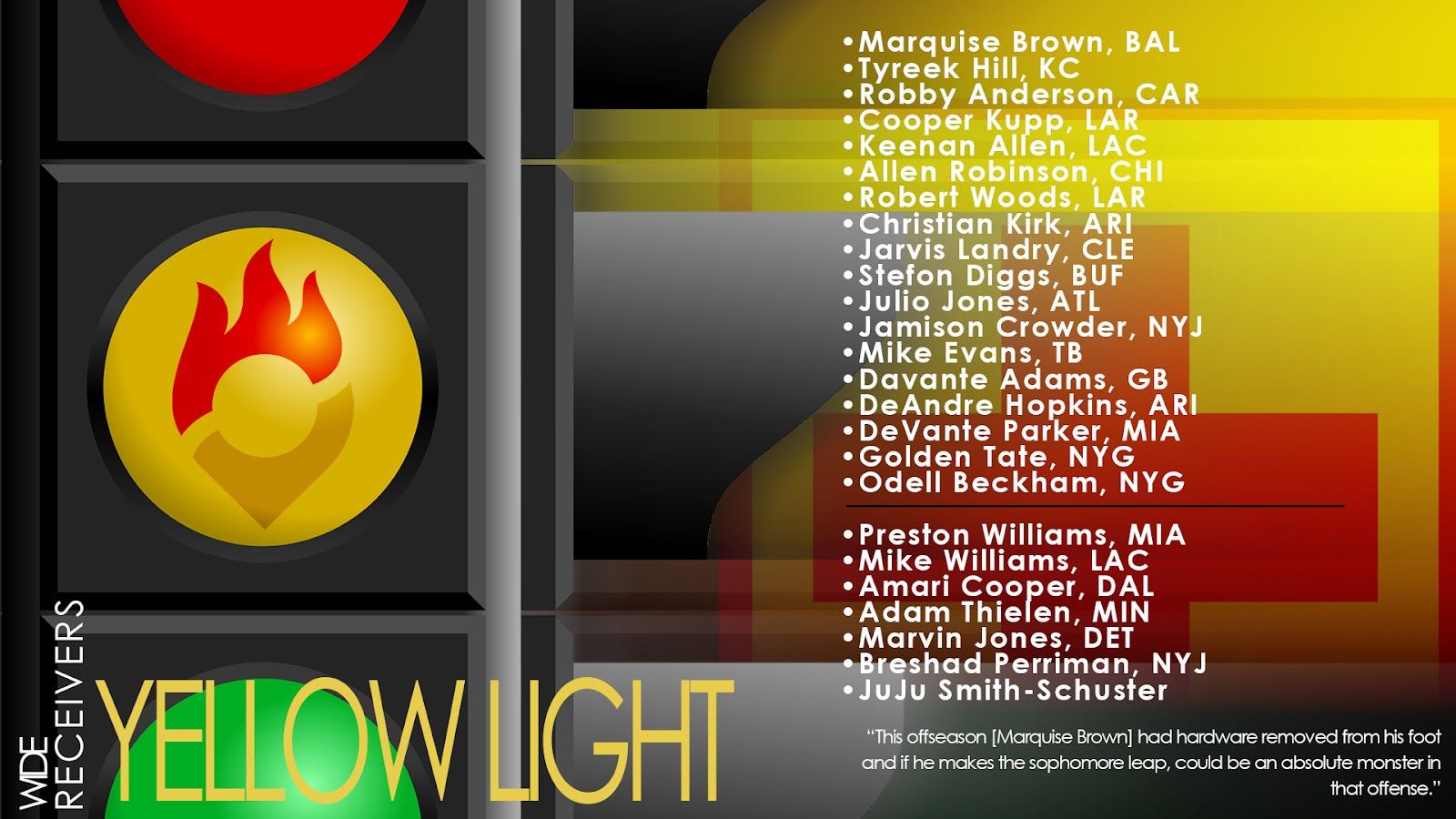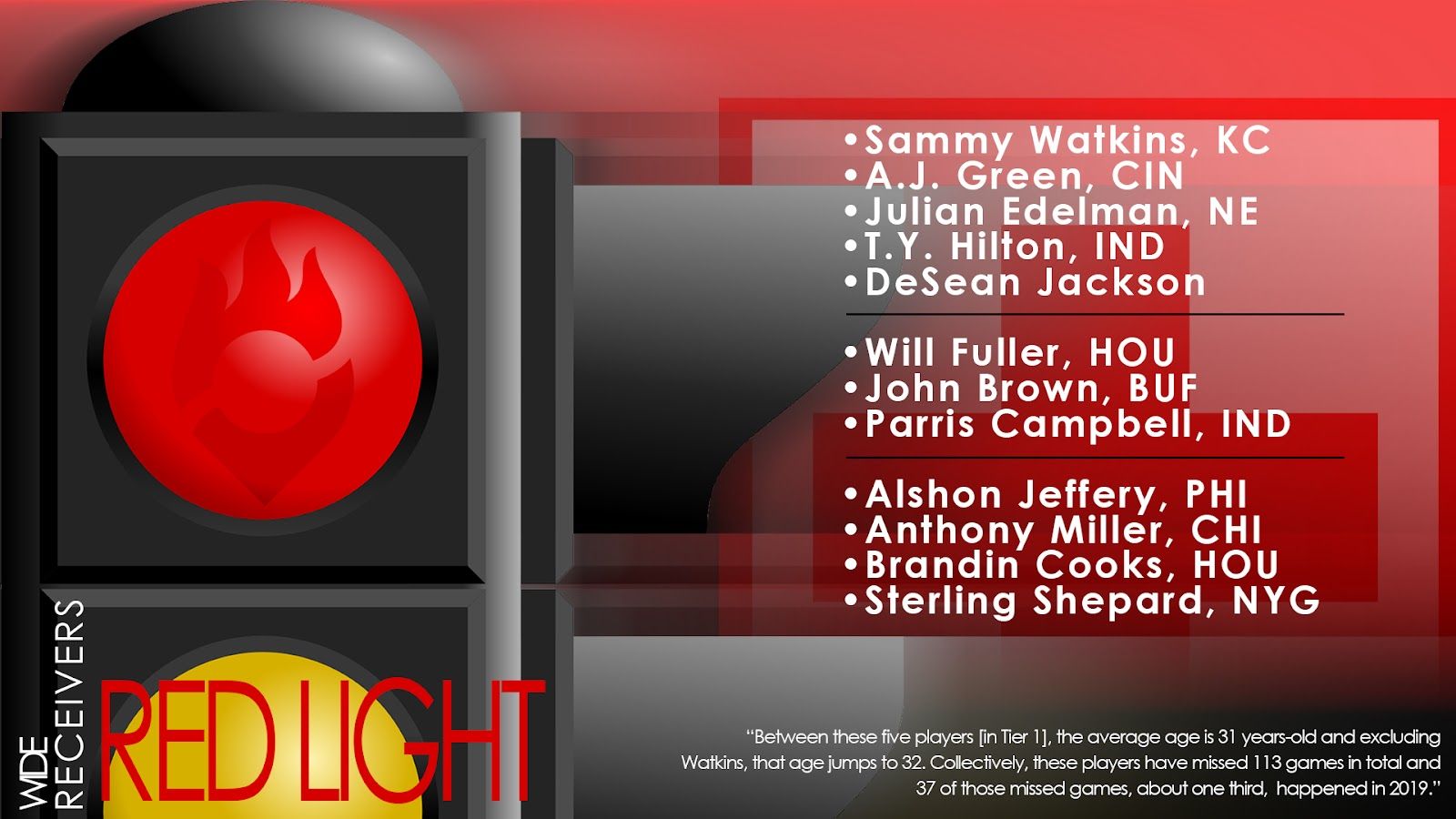Update: With the news of Deebo Samuel having a Jones fracture, he tumbles down to the bottom of the Yellow Light tier.
If you haven’t read my Running Back Physical Volatility Tiers article, it might help to start there.
What This Is
- An imperfect analysis of the top 60 veteran wide receivers’’ injury risk and physical performance potential using medical research and injury statistics, written from a rehabilitation specialist’s point of view.
- A highly-individualized analysis for the 2020 season. I reserve the right to scrap and/or alter this season’s process for a more individualized approach in the seasons to come.
What This Isn’t
- An “Injury prediction” article.
- An injury prediction “model.”
- A strict evaluation of a player’s talent and/or overall fantasy potential.
For rankings and projections, I left it to the professionals here at Fantasy Points. My work merely complements theirs. I also understand fantasy players want some guidance on the chance of injury and volatility of physical health. Enter this pseudo-scientific attempt at quantifying players’ injury risk. Ultimately, the goal is to compile master “volatility” tiers. For now, the focus is on the top 60 veteran wide receivers going into 2020. The rookie wide receivers will have a tiers article of their own coming soon.
Methods
The methodology to score the injury risk of receivers is very similar to calculations for running backs, but there are key differences to be aware of. As mentioned, injury “prediction” is a fool’s errand, especially in football, as just 2.3% of games are injury-free. However, there are basic orthopedic principles and medical statistics that help to estimate the physical health and performance volatility in NFL wide receivers:
- The three most common injuries among wide receivers are to the shoulder, ankle, and hamstring.
- Hamstrings recur at a rate of 34% among wide receivers and 20% occur within a calendar year.
- Wide receivers are the skill position that is most frequently affected by concussions.
- Players who are coming back from Lisfranc surgery see an average dip of 21% in offensive production the first season after surgery. In the second year after surgery, those numbers rebound.
- Players coming off a sports hernia surgery do not see a dip in performance.
- Overall, wide receivers are injured more frequently than running backs, even after accounting for the amount of players at both positions.
Quantifying Volatility
A player’s volatility can be thought of in two branches: athleticism and injury risk. The first branch is best reflected by age since there’s a decline in athleticism every year after a certain point. To reflect the aging process, each player was assigned 0.25 points for every year they were over the age of 26 (26 is the average age of top-10 fantasy receivers since 2016). Additionally, every receiver received a score of 1 for the three most common injuries of the position (ankle/hamstring/concussion) so the baseline score of every player is 3. To further quantify each players’ risk, recurrence data from the medical research on NFL players was utilized if available (recurrence is defined as the percentage of receivers who sustain an injury more than once in a career). If a recurrence rate wasn’t available in the medical literature, it was calculated manually using the injury reports from 2016-2019. For example, ACL recurrence is 18% and is represented by 0.18 in the volatility score, an ankle sprain recurs at 10% and is represented by 0.10 in the score, etc. If a player had a history of a hamstring injury they were assigned 0.34 to represent the 34% recurrence rate. Similarly, players were assigned 0.20 if the hamstring injury was within the last calendar year. To represent the fact that every injury is not created equally, the “clinical judgment” section was used to adjust for any discrepancy that might not truly represent a player’s volatility. This is similar to the idea of raw projections vs. rankings, but is the most subjective portion of the process.
To make the process more clear, consider Odell Beckham Jr. as an example:
1 point for each of the three most common wide receiver injuries (shoulder/ankle/hamstring) = 3
0.25 points for being one year older than 26 years old. The number 0.25 is subjective -- the intent is to represent that aging adds to the player’s physical volatility.
0.25 points for a previous ankle surgery. The number 0.25 is subjective- the intent is to represent that major surgery of a joint adds to the player’s physical volatility.
0.1 point to account for the 10% ankle injury recurrence rate.
0.34 points to account for 34% hamstring injury recurrence rate
0.5 points because medically, I believe it’s appropriate to add more to his overall volatility given his history.
= 4.44
A full breakdown of assigned units for each injury/performance factor is in the table below.
| Characteristic | Data Type | Value | Assignment Description |
| Hamstring | Medical | 1 | All at baseline |
| Concussion | Medical | 1 | All at baseline |
| Ankle | Medical | 1 | All at baseline |
| R-Hamstring | Medical | 0.34 | Once per player history |
| R-Shoulder | Medical | 0.1 or 0.26 or 0.5 | AC sprain/surgical dislocation/dislocation |
| R-Ankle | Manual | 0.1 | Once per player history |
| R-Concussion | Manual | 0.25 | Once per player history |
| R-ACL | Medical | 0.18 | Once per player history |
| R-Groin | Manual | 0.1 | Non-surgical groin injury recurrence |
| Hand | Manual | 0.1 | Variable based on situation |
| Foot | Medical | 0.21 | 1 year post-op Lisfranc |
| Joint Surgery | Manual | 0.25-0.75 | Variable based on joint surgery and/or fracture |
| Age | Medical/Manual/Subjective | 0.25 | Once every year > 26 |
| Clinical Judgment | Subjective | Variable | Variable |
| R = Recurrence | |||
| T = Targets |
Raw Results
The final score represents each player’s physical volatility score due to previous injury and overall athleticism. Although not perfect, last year players with a high score are A.J. Green and Alshon Jeffery. Players with a low score in 2019 are Michael Thomas, Kenny Golladay, and Darius Slayton among several others. There were many more players in the “Green Light” tier who did finish 2019 with minimal injury issues, which represents the fact that the previous injury is the most important factor to reasonably project a player’s future health and availability. Wide receivers differ from running backs in that they are injured more frequently so overall volatility is naturally higher. It’s important to understand that even though receivers are injured more often, it doesn’t mean they necessarily miss games more frequently.
There are obviously several weaknesses to this methodology; but if nothing else, it walks users through how I think of players relative to each other and why. The tiers are split into the traditional “green light,” “yellow light,” and “red light” analogy with a description for each tier. Lastly, keep in mind that the lower a player is in a tier, the more physically volatile he is. For example, even though they’re both in the Green Light Tier, DK Metcalf is more volatile than Michael Thomas.
Results
Green Light Tier
Micahel Thomas, and Kenny Golladay are durability warriors at the wide receiver position. Their most severe injuries are a sports hernia that required surgery (Thomas in 2015) and an elbow dislocation (Golladay in 2016). Sports hernia surgery is extremely successful and Golladay’s issue, which was rather flukey to begin with, hasn’t lingered at all.
The first break in the Green Light tier starts with Calvin Ridley. Both Ridley and Diontae Johnson are both coming off sports hernia surgeries like Michael Thomas had, but Ridley and Johnson haven’t shown the same longevity quite yet. Aside from “minor” surgical procedures, the rest of the players in this tier have had a hamstring or groin strain but for 2019 rookie receivers like AJ Brown and Darius Slayton these injuries are expected because of the massive shift in workout routines and overall workload-- they should get past it.
The third mini-tier in the Green Light section runs from Michael Gallup to DK Metcalf who both had an arthroscopic “clean up” of the knee joint in 2019. This procedure is still a trauma to the body, but overall the long-term effects are negligible.
The final mini-tier starts with (DJ Moore) who had his first concussion in 2019. I struggled with whether or not these players, fresh off of a season with a concussion or a combination of a concussion and a hamstring strain, belong in the Green or Yellow Light Tier. In the end, they’ll need to get through the 2020 season without re-injury, but indeed will remain in the Green Light Tier. If you decided to interchange players from this final tier with the top players in the next tier, I wouldn’t blame you.
Green Light Tier Takeaway
This tier is headed by two durable receivers in Thomas and Golladay and is followed by a few players with surgical procedures and hamstring injuries. It’s rounded off by another group of receivers who primarily suffered concussions and hamstring strains in 2019 but are otherwise durable. This entire tier includes players who have a few bumps and bruises that are not insignificant but are not detrimental to their 2020 outcome yet. Most of the players in this tier are under the age of 25 and are primed for long careers barring unforeseen circumstances.
Yellow Light Tier
Similar to the running backs in the Yellow Light Tier, the guys above are all technically card-carrying members of the Yellow Light Tier, but another mini-tier exists after Odell Beckham Jr. where the injury risk becomes more tangible.
This first half of this Yellow Light Tier can be described as the kind of yellow light that you’ll beat without an issue, but the car behind you won’t. These players are not inherently “at risk” for injury; however, they have not been the picture of health recently. This includes OBJ, who demonstrates consistent soft tissue strains and recently underwent surgery, Tyreek Hill, who recently dislocated a joint, and Davante Adams who has a significant history of three concussions dating back to 2017. They’re kept by the company of an aging Julio Jones as well as Mike Evans, who finished the season on the injured reserve due to a hamstring strain recurrence. Evans also has a significant history of groin strains and given that he’s the average age of wide receivers who strain a hamstring (26), he doesn’t come without injury volatility. The hidden gem of this tier is Marquise Brown who will be in his second year after a Lisfranc procedure. This offseason he had hardware removed from his foot and if he makes the sophomore leap, he could be an absolute monster in that offense. Another archetype in this mini Yellow Light Tier is Keenan Allen, who has shown to be consistently durable but should be approached with caution due to his recent hamstring injury and aging body with a history of surgeries. A similar concept applies to Cooper Kupp and Allen Robinson. Overall, these players aren’t slam dunks from a health perspective, but are better off than players in the second half of the tier.
The second half of the Yellow Light Tier features Mike Williams and Amari Cooper, two players who have chronic conditions (disc herniation for Wiliams and plantar fasciitis for Cooper). Although those conditions can be managed, they can also strike at any minute either causing a reduction in performance or no availability at all. Next is 30 year-old Adam Thielen who has a history of a massive hamstring tear in 2019. He could certainly deliver great performances in 2020, but he comes with some risk compared to his peers who play receiver. Additionally, Marvin Jones has had two ankle injuries and finished 2019 on the IR due to another ankle issue. At age 30, his services are ideally a rental in 2020. Perhaps the headliner of this mini-tier is JuJu Smith-Schuster who has unfortunately suffered three concussions since 2017, which has flown under the radar. This not only puts his playing career at risk, but his long-term health as well. Some receivers like DeAndre Hopkins and Davante Adams have been able to continue playing despite early career concussions, but those concussions are the same reason they’re in the Yellow Light tier themselves.
Yellow Light Tier Takeaway
The first half of this tier are players with a history of missing a few games or they’ve simply racked up surgeries and injuries that could slow them down in 2020. This is also the pseudo-geriatric tier, as almost all of them are at least 26. As mentioned before, 26 tends to be the beginning of the end for players in their physical prime. If age isn’t an issue, recurrent muscular strains, ACL surgery, chronic conditions, and/or concussions have led these players to be in the Yellow Light Tier.
Red Light Tier
The first third of the Red Light Tier is where worries begin. Between these five players, the average age is 31, and excluding Watkins, that age jumps to 32. Collectively, these players have missed 113 games in total, and 37 of those missed games happened in 2019. What’s worse is that going back to 2018, they missed another total of 19 due to injury. That’s to say that since 2018, 50% of the 113 missed games due to injury happened over the last two years. Age, concussions, surgeries, fractures, and ruptured ligaments makes these players physically volatile in 2020. This isn’t to say they can’t be productive, but expectations should be tempered for what they are capable of in 2020.
The second third of the Red Light Tier starts with a player who needs no introduction. Unfortunately, Will Fuller hasn’t been able to stay on the field due to muscular strains and now he’s coming off of a groin surgery. John Brown saw his production take a big hit in the second half of 2019 and at 30 years-old, might see his play decline. Additionally, could sickle-cell trait potentially predispose him to being symptomatic should he contract COVID-19? Why did Parris Campbell have two fractures in the span of a month? Will his recent groin injury come back up in 2020? This second Red Light mini-tier has more questions than answers.
The last mini-tier features a 30-year-old Alshon Jeffrey coming off a Lisfranc procedure, Anthony Miller who had yet another shoulder surgery in 2020 to prevent dislocation, as well as Brandin Cooks and Sterling Shepard, who have combined for nearly ten concussions. I’m concerned for these players, particularly Shepard and Cooks, as humans before I even begin to think about the fantasy implications. The hope is they can prove me wrong.
Conclusion
Receivers were extremely tough to decipher this year, but the goal is to help you visualize how to view these players from a physical perspective. The Green Light Tier is full of young studs with minimal concerns mixed in with a few veterans who have shown to be durable. The Yellow Light Tier is jam-packed with players who are not inherent injury risks, but could end up losing a step or missing games in 2020. Lastly, the Red Light Tier can be called the Truly Questionable tier because how they perform in 2020 is extremely volatile and a history of significant injuries along with age will dictate their production.











